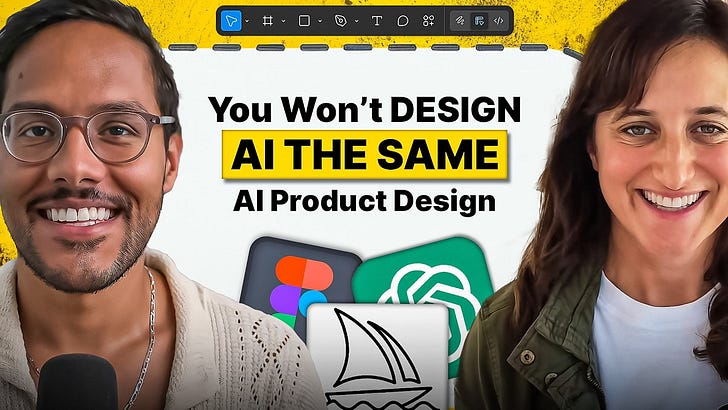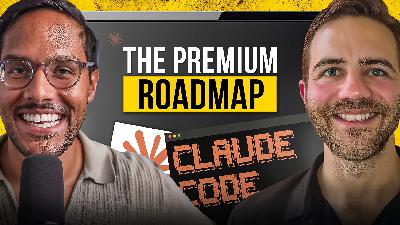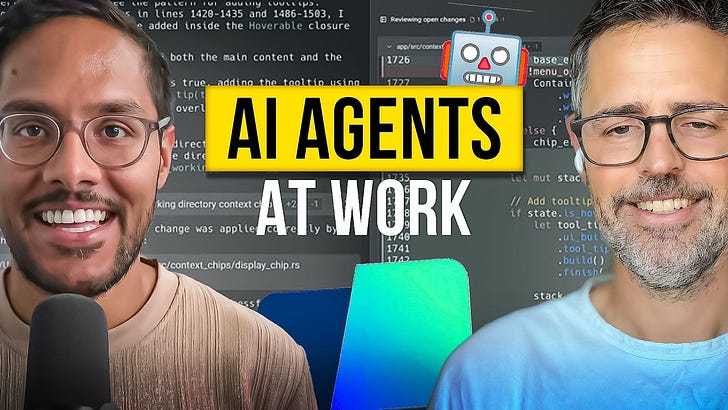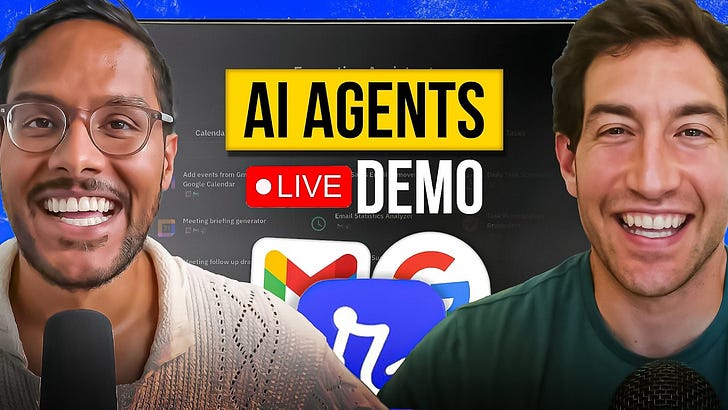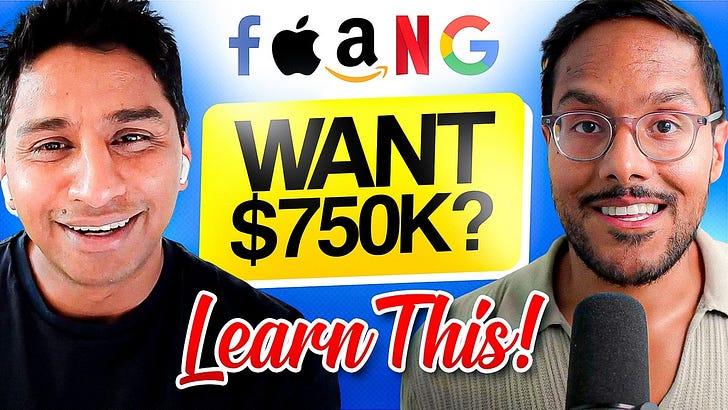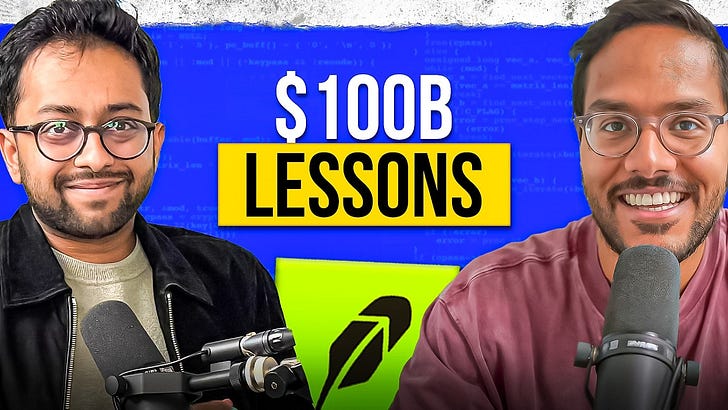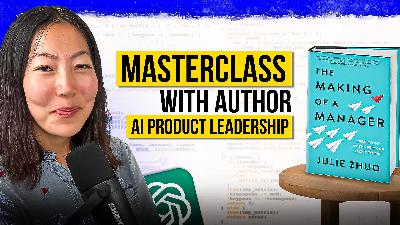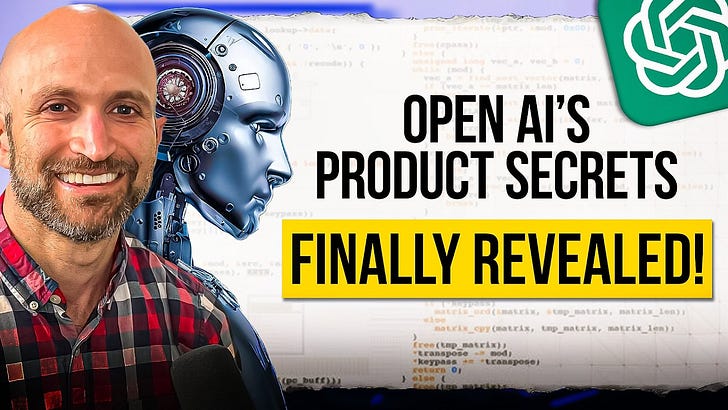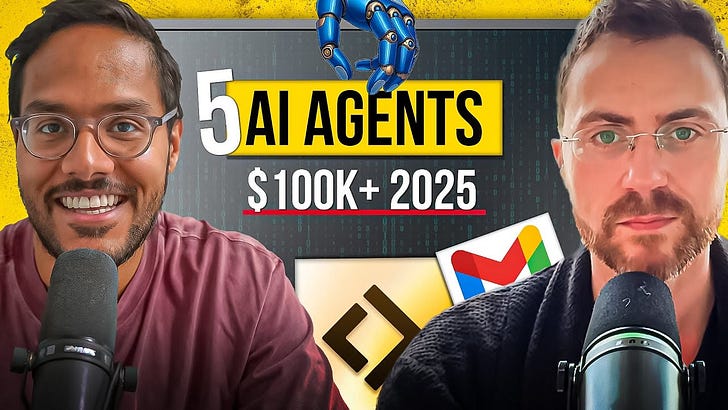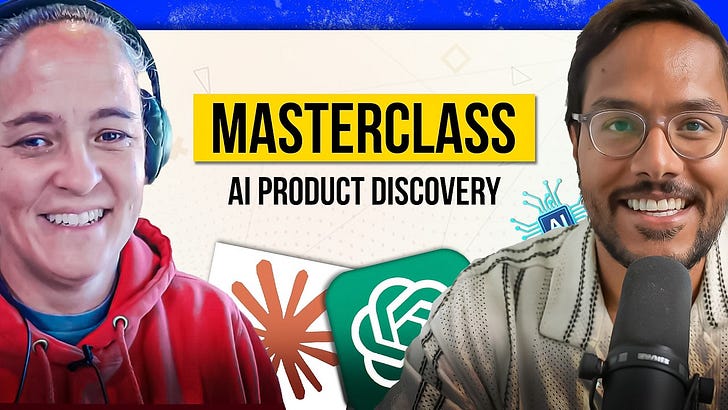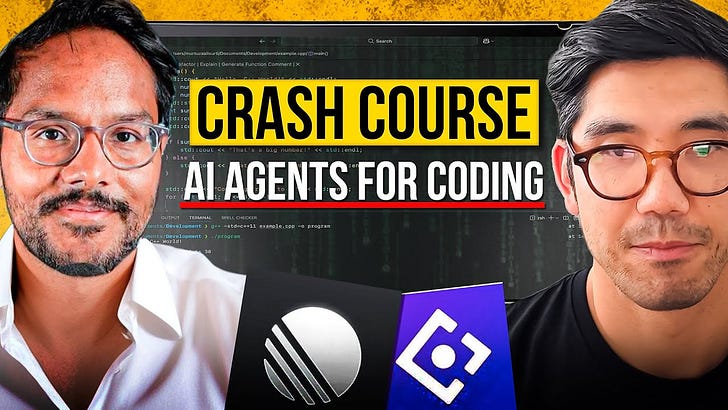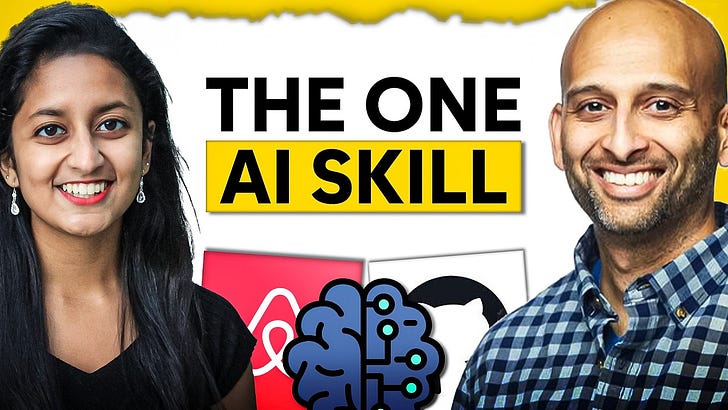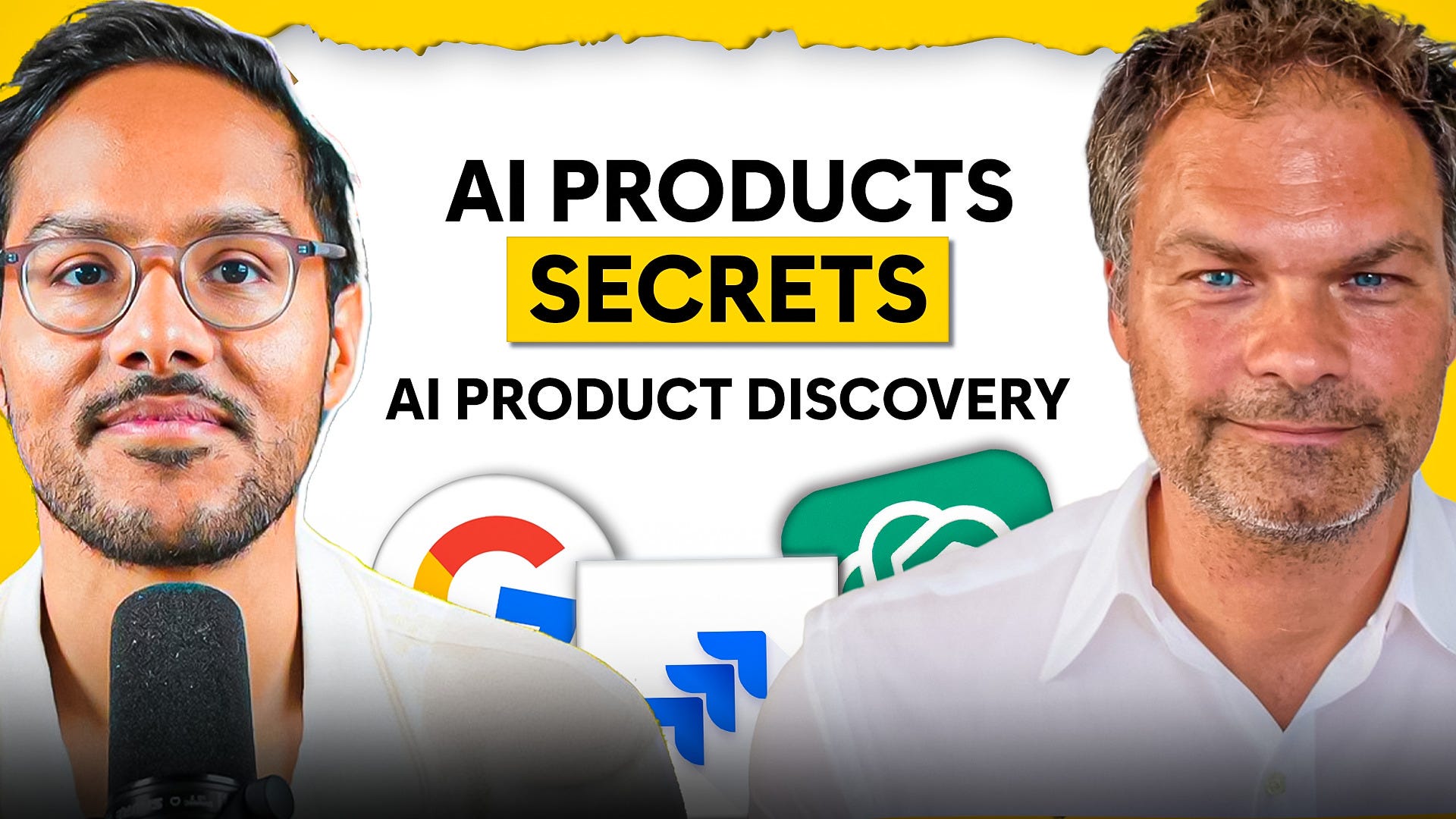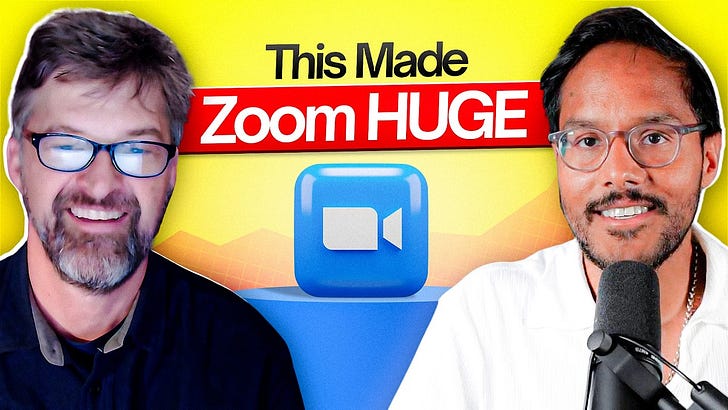Discover Product Growth Podcast
Product Growth Podcast

Product Growth Podcast
Author: Aakash Gupta
Subscribed: 301Played: 2,064Subscribe
Share
© Aakash Gupta
Description
The latest insights into how great products grow, how to be a better PM or product leader, and how to get a PM job.
www.news.aakashg.com
www.news.aakashg.com
102 Episodes
Reverse
Today’s EpisodeEveryone’s building AI products wrong.They’re sprinkling AI on top like fairy dust. Adding chat interfaces to everything. Ignoring 70 years of design principles.Elizabeth Laraki was one of 4 designers on Google Search in 2006. One of 2 designers on Google Maps in 2007. She helped create products used by billions—products whose designs barely changed for 15+ years because they nailed it from the start.Today she breaks down exactly how to design AI features that users actually love.----Check out the conversation on Apple, Spotify and YouTube.Brought to you by:* Vanta: Automate compliance, manage risk, and prove trust* Kameleoon: Leading AI experimentation platform* The AI PM Certificate: Get $550 off with ‘AAKASH550C7’* The AI Evals Course for PMs: Get $1155 off with code ‘ag-evals’----Timestamps:00:00:00 - Intro00:01:52 - Elizabeth's background at Google00:04:19 - Google's AI search integration00:06:19 - Designing image & video for AI00:09:44 - AI image expander disaster00:16:05 - Ads00:17:50 - AI safeguards & human-in-the-loop00:18:28 - 3-step AI design process00:31:29 - Ads00:33:25 - Designing AI voice interfaces00:38:25 - Designing beyond chat00:41:52 - AI design tools for designers00:44:49 - Live design: LinkedIn for AI00:57:04 - Google Maps redesign story01:04:14 - Google Maps India landmarks01:10:09 - Where to find Elizabeth01:12:00 - Outro----Key Takeaways1. The Core Design Process Hasn't Changed: Define the product (who, what tasks, what needs), Design it (features, architecture, flows), Build it (UIs, brand). Don't skip to "let's add a chatbot" because you have API access. The fundamentals still apply for AI.2. AI Adds Non-Deterministic Risk: Traditional software is deterministic - click A, get B every time. AI is non-deterministic with unpredictable outputs. Elizabeth's image expander added a bra strap that wasn't in the original photo. Completely unintentional, completely unacceptable.3. Work With Research on Safeguards: Audit training data for bias. Build evals that flag sensitive content (human bodies, faces, private information). Show A/B options for ambiguous cases. Make AI's work visible in the UI so users can scrutinize changes.4. Start With Jobs To Be Done: Don't ask "We have GPT-4, what should we build?" Ask "What painful workflow takes users hours?" Descript mapped video editing lifecycle and baked AI into each job: remove filler words, edit from transcript, create clips, write titles.5. Map User Context, Not Just Needs: ChatGPT voice in car with three kids? Perfect - nobody's looking at screen. Meta Ray-Bans reading Spanish menu item by item? Terrible - should ask "What are you in the mood for?" Same AI, different context requires different design.6. Emerge From Ambiguity First: For "LinkedIn for AI," Elizabeth mapped 4 possible directions, picked Matchmaking, identified AI's unlock (personality patterns vs keyword matching), mapped separate UIs for job seekers and employers. Only then touch pixels.7. Chat Fails for Complex Tasks: Elizabeth tried creating Madrid itinerary in ChatGPT. Every change regenerated everything with new hallucinations. Chat works for Q&A but fails for document creation, visual tasks, multi-step workflows that need persistent editable outputs.8. Make Chat Supporting, Not Primary: Photoshop embeds AI in existing canvas tools. Google Search shows AI summaries inline in normal results. Cove gives canvas with multiple AI conversations in parallel. Chat is a tool, not THE interface.9. Stop Adding AI Sprinkles: Elizabeth: "I can't help but think of this massive container of AI sprinkles everybody's shoving on top." Twitter/X + Grok, Amazon + Rufus, Apple Photos all feel forced. Ask three questions: Is this solving a real problem? Does chat make sense? Can you show your work?10. Google Maps India Innovation: Researched how Indians actually navigate (by landmarks, not street names). Identified which landmarks work (visible from street level like temples, petrol stations). Redesigned entire directions system around that insight. That's design, whether AI or not.----Where to Find Elizabeth Laraki* Linkedin* X (Twitter)----Related ContentPodcasts:What it means to be Design-LedComplete Tutorial to AI Prototyping5 AI Agents Every PM Should BuildNewsletters:Ultimate Guide to Product DesignUltimate Guide to AI PrototypingHow to Work With Design for Success----P.S. More than 85% of you aren’t subscribed yet. If you can subscribe on YouTube, follow on Apple & Spotify, my commitment to you is that we’ll continue making this content better.----If you want to advertise, email productgrowthppp at gmail. This is a public episode. If you'd like to discuss this with other subscribers or get access to bonus episodes, visit www.news.aakashg.com/subscribe
Today’s EpisodeClaude Code hit $500 million ARR in four months.Two product managers. Zero marketing dollars. Just pure viral growth.While some PMs are still copying and pasting into ChatGPT, others are orchestrating multiple AI agents that work in parallel, automatically reading files, researching competitors, and building prototypes.Carl Vellotti runs the world’s largest PM Instagram account (55K followers) and has mastered Claude Code better than almost anyone. He’s built his own meme generation system, automated his content workflow, and uses Claude Code for everything from research to prototyping.Today’s tutorial takes you from beginner to Claude Code hero.----Check out the conversation on Apple, Spotify and YouTube.Brought to you by:* Linear: Plan and build products like the best----Key Takeaways1/ Stop Working in Chat WindowsTraditional chat requires manually dragging files one at a time. Claude Code lives in your terminal and automatically reads entire folder structures. The interface was the bottleneck all along.2/ Build Your Knowledge Base FirstCreate four folders: business-info.md for product context, writing-styles/ for different voices, examples/ for past PRDs, meeting-transcripts/ for automatic uploads. One prompt pulls from everything.3/ Use the CLAUDE File for MemoryAdd rules once, they persist forever. "Never commit without asking." "Always use technical writing." Unlike prompts that get lost in context windows, this stays active every session.4/ Save Your Best Prompts as CommandsCreate /meeting-notes, /competitive-research, /prd-review. Save once, reuse forever. No more hunting through old Twitter bookmarks for that perfect prompt.5/ Let Claude Plan Before ExecutingPress Shift+Tab for Plan Mode. Claude creates full execution plan without touching files. You review, catch mistakes, then approve. This one habit prevents 80% of AI disasters.6/ Parallelize Everything You CanNeed to analyze 3 customer interviews? Claude spins up 3 UXR agents working simultaneously. Week of manual work becomes 1 hour with parallel agents.7/ Build Custom Agent PersonalitiesDesigner agent focuses on UX. Engineer agent checks technical constraints. Executive agent evaluates business impact. All three review your PRD simultaneously with specialized perspectives.8/ Use the $37/Month ComboClaude Pro ($17) handles research and writing perfectly. Add Cursor ($20) for heavy coding. You get best models for $37 instead of $200/month Claude Max.9/ Only See Token Usage HereClaude Code shows real-time token consumption and cost. Finally understand what API pricing actually means. No other interface gives you this visibility.10/ Start Simple Then ScaleBegin with one research task using file analysis. Add a custom command. Try parallel agents once. You'll never go back to chat interfaces.----Where to Find Carl Vellotti* Linkedin* X (Twitter)* Instagram----Related ContentPodcasts:Cursor TutorialWindsurf TutorialAI Prototyping TutorialNewsletters:AI Agents: The Ultimate Guide for PMsUltimate Guide to AI Prototyping ToolsHow to Land a $300K+ AI Product Manager Job----P.S. More than 85% of you aren’t subscribed yet. If you can subscribe on YouTube, follow on Apple & Spotify, my commitment to you is that we’ll continue making this content better.----If you want to advertise, email productgrowthppp at gmail. This is a public episode. If you'd like to discuss this with other subscribers or get access to bonus episodes, visit www.news.aakashg.com/subscribe
Today’s EpisodeAs an AI PM, you’re probably tired of building AI Agents and don’t know how to monetize them.But what if I told you there’s a company adding $1 million ARR every 10 days with their AI agent?Zach Lloyd, CEO of Warp and former Google engineering leader, cracked the code. His terminal-based AI agent has 700,000+ active developers paying real money.This episode is his complete playbook for AI PMs who want to build agents that actually make money.I hope you enjoy this one!----Brought to you by:* Vanta: Automate compliance, manage risk, and prove trust* Kameleoon: Leading AI experimentation platform* Amplitude: The market-leader in product analytics* The AI Evals Course for PMs: Get $1155 off with code ‘ag-evals’----Timestamps00:00:00 - Intro00:01:55 - Interview Begins00:02:02 - Warp's Scale & Growth00:03:08 - The Turning Point00:04:32 - Learn or Get Left Behind00:05:50 - Framework for AI Value00:08:30 - Warp's Development Process00:12:28 - UX Challenges in Agentic Products00:14:53 - Ads00:19:29 - Who's Making Money with Agents00:28:31 - Future Predictions00:29:24 - Ads00:30:26 - Contrarian Takes on AI's Future00:35:44 - 90-Day Roadmap for PMs00:38:33 - Outro----Key Takeaways----Where to Find Zach Lloyd* Linkedin* X (Twitter)* Warp----Related ContentPodcasts:* He built the top AI agent startup* AI Agents for PMs in 69 Minutes* How to Build AI Agents (and Get Paid $750K+)Newsletters:* AI Agents: The Ultimate Guide for PMs* Ultimate Guide to AI Prototyping Tools* How to Land a $300K+ AI Product Manager Job----P.S. More than 85% of you aren’t subscribed yet. If you can subscribe on YouTube, follow on Apple & Spotify, my commitment to you is that we’ll continue making this content better.----If you want to advertise, email productgrowthppp at gmail. This is a public episode. If you'd like to discuss this with other subscribers or get access to bonus episodes, visit www.news.aakashg.com/subscribe
Today's EpisodeHere's what's happening right now:Someone can clone your voice from a few YouTube videos and call your help desk pretending to be you.AI can build a perfect fake of your login page in minutes.This isn't some distant future threat. Jack Hirsch, VP of Product at Okta, sees this happening every day. Okta protects millions of logins and Jack has a front-row seat to how AI is completely changing cyber attacks.And the scary part is most PMs have no idea this is happening to their products.That's why I brought Jack on the show. He breaks down what's really happening and what you need to know as someone building products in the AI era.----Brought to you by:* Amplitude: The market-leader in product analytics* The AI Evals Course for PMs: Get $1155 off with code ‘ag-evals’* The AI PM Certificate: The #1 AI PM certificate* Kameleoon: Leading AI experimentation platform----Key Takeaways1. Identity is Everything: Over 80% of breaches stem from identity attacks, not device or network vulnerabilities. You cannot get security right without getting identity right - this is the new reality.2. DPRK Infiltration Operations: North Korean agents are passing full interview processes, getting hired, having laptops shipped to device farms, and operating as inside threats within major organizations.3. AI Agents = Security Blindspot: Companies deploy AI agents en masse without treating them as identities requiring access management. JP Morgan's CISO called this out as the biggest current threat vector.4. Help Desk Social Engineering: Attackers use AI voice cloning and deepfakes to impersonate employees calling help desk for password resets, MFA bypasses, and account access - often successfully.5. Session Security Over Time: Authentication degrades after login. Okta focuses on continuous session monitoring and risk signal sharing between security vendors rather than constant MFA prompts.6. T-Shaped Identity Strategy: Deep identity security (phishing-resistant auth, lifecycle management, risk sharing) plus broad integration across all enterprise systems - not just SSO and MFA.7. Cross-App Access Standard: New OAuth standard allows AI agents to inherit user permissions across enterprise apps without individual OAuth dances for thousands of employees.8. Essential vs Discretionary AI: Essential AI (bot detection, fraud prevention) stays always-on. Discretionary AI (log summaries, access reviews) gives customers opt-out control for compliance.9. AI Product Principles: Accelerate don't abdicate, solve real problems before prototyping, ignore AI hype cycle. Use AI as thought partner, not replacement for product judgment and domain expertise.10. Personal Security Stack: Lock credit reports immediately, use password manager with unique passwords, enable passkeys everywhere, lock phone number with carrier PIN to prevent SIM swapping attacks.----Related ContentPodcasts:How to Get a Product Leadership JobHow He Became a Series C VP of Product in 10 Years“Product Management isn’t going to exist in 5 years” - 2x CPONewsletters:The Product Leadership Job SearchThe Product Leader’s Ultimate Guide to Process ChangesProduct Leadership Interviews (GPM, Director, VP): How to Succeed----P.S. More than 85% of you aren't subscribed yet. If you can subscribe on YouTube, follow on Apple & Spotify, my commitment to you is that we'll continue making this content better.----If you want to advertise, email productgrowthppp at gmail. This is a public episode. If you'd like to discuss this with other subscribers or get access to bonus episodes, visit www.news.aakashg.com/subscribe
You use ChatGPT. But being an AI-powered PM means also using AI agents.In my slack poll, only 2% of you said you use AI agents for productivity. So I want to break that down and make it dead clear: 1) why you should use AI agents and 2) how you should build them.So in today’s episode, I’ve brought in Jacob Bank, former Director of PM at Google (Gmail, Calendar) and now CEO of the AI agent builder company Relay.app.He shares all his secrets - his 12 agent EA, his 40 agent marketing team, and his agent to synthesize agent updates. I hope you enjoy.----🏆 Thanks to our sponsors:Miro: The innovation workspace is your team's new canvasJira Product Discovery: Plan with purpose, ship with confidenceMobbin: Discover real-world design inspirationProduct Faculty: Product Strategy Certificate for Leaders (Get $550 off)----⏰ Timestamps:00:00 Intro01:49 Meet Jacob: The AI Agent Pioneer02:18 Managing Agent Notification Overload04:13 Current AI Agent Limitations Explained06:59 Relay's Growth & Bootstrap Strategy10:25 The Bull Case for AI Agent Market15:14 Ads17:18 Who's Adopting AI Agents Fastest20:46 Top 10 AI Agent Use Cases for PMs22:48 Choosing the Right Agent Platform28:44 Jacob's 55-Agent Marketing Team Breakdown31:47 Ads34:45 Building AI Agents Into Your Product38:10 MCP Protocol & Future of APIs41:43 Why Jacob Left Google Director Role44:25 Brutal Truth: PM-to-Founder Reality Check48:52 Outro----Key Takeaways1. Real agents need five components working togetherIntelligence (LLM), Knowledge (proprietary data), Memory (interaction history), Tools (APIs that change world state), Guardrails (validation and safety). Most "agents" are just LLM wrappers missing the other four components.2. No-code tools compress development cycles 100xLangflow + v0 enable 30-minute prototype-to-production workflows. Build competitive analysis agents live on screen. The cost barrier disappeared while customers still can't articulate what they want until they see it working.3. Cart-before-horse development beats traditional PM processSkip months of research. Build working prototypes first, test with real users, iterate based on feedback, then write focused PRDs. Speed beats perfection when technology moves this fast.4. FAANG salaries reflect desperate demandLevel 6-7: $750K+ total compensation. Level 8+: $1.2-1.5M total compensation. OpenAI: $900K+ for comparable roles. Growth rate: 2-3x faster than traditional PM positions because supply can't meet demand.5. The proven 18-month roadmap works systematicallyMonths 1-3: master fundamentals, build working agent solving personal problems. Months 4-9: scale to 10-20 real users, learn evaluation systems. Months 10-18: contribute to open source, prove you outperform existing team members.6. Vibe coding interviews test product judgment, not technical skillsDemonstrate structured thinking through prompt engineering, incorporate user insights in second iterations, show measurement frameworks in third iterations. They're evaluating product sense through AI interactions.7. Target problems with three characteristics for defensibilityDomain expertise you already possess, unstructured data requirements, complex decision-making processes. This combination creates competitive moats that simple AI features cannot replicate easily.8. Evaluation frameworks must come before codingMeasure usage adoption, outcome achievement, and user experience satisfaction. Include speed metrics (prompts to completion) and accuracy benchmarks (goal success rates) to validate that AI actually democratizes building.9. Company cultures reward different AI approachesMicrosoft: innovation without business constraints. Amazon: profit-focused execution speed. Meta: collaboration with world-class engineering talent. Google: user experience perfection with iteration time.10. Essential PM tools everyone needsCustomer interaction analyzer across all channels, AB testing simulator using AI personas at scale, document reviewer trained on your manager's specific feedback patterns an----Related ContentRelated Podcasts:* He built the top AI agent startup* AI Agents for PMs in 69 Minutes* How to Build AI Agents (and Get Paid $750K+)Realated Newsletters:* AI Agents: The Ultimate Guide for PMs* Ultimate Guide to AI Prototyping Tools* How to Land a $300K+ AI Product Manager Job----P.S. More than 85% of you aren't subscribed yet. If you can subscribe on YouTube, follow on Apple & Spotify, my commitment to you is that we'll continue making this content better.----If you want to advertise, email productgrowthppp at gmail. This is a public episode. If you'd like to discuss this with other subscribers or get access to bonus episodes, visit www.news.aakashg.com/subscribe
AI agent PM roles are the fastest-growing, highest-paid positions in tech. These jobs pay $750K+ (TC in SF/NY) and are growing 2-3x faster than traditional PM roles.But most people don't know how to actually build AI agents. They think it's just ChatGPT with a fancy interface.Today I sat down with Mahesh Yadav, who's worked as a PM at Meta, Amazon, Microsoft, and Google. He's built AI agents at scale for 8+ years and now teaches hundreds of PMs at top companies.He breaks down the exact playbook: how to build agents, the 18-month roadmap to $750K+ roles, and what FAANG companies look for in vibe coding interviews.If you want to learn to build AI agents, this is your blueprint.Check out the conversation on Apple, Spotify and YouTube.----Brought to you by:* Maven: Get $100 off my curation of their top courses with code ‘AAKASH550C7’* Miro: The innovation workspace is your team’s new canvas* Kameleoon: Leading AI experimentation platform* The AI Evals Course for PMs & Engineers: Get $1155 off with code ‘ag-evals’* Amplitude: The market-leader in product analytics----Timestamps00:00 - Introduction & Overview01:40 - What Makes an AI Agent PM02:37 - Building the Backend Agent16:32 - Creating the Frontend with V025:27 - What Defines an AI Agent vs AI Product30:15 - AI PM Interview Requirements34:08 - Cart Before the Horse Development37:15 - Breaking into FAANG: Mahesh's Story42:17 - Internal Transfer Strategy50:40 - Comparing Microsoft vs Amazon vs Meta vs Google54:28 - AI Agent PM Job Market & Salary Data57:26 - Can Anyone Become an AI PM?59:14 - 18-Month Roadmap to AI PM1:05:01 - AI Agents for Regular PMs1:08:47 - Business of Mahesh & Course Success----10 Steps to a $750K+ AI Agents Job:1. Build First (Not Study)The biggest mistake aspiring AI PMs make is spending months reading about AI instead of building. Companies like Google aren't looking for people who know frameworks—they want builders who have actually shipped AI products. Start with tools like Langflow for no-code backends and V0 for frontends.2. Master AI FundamentalsYou need to know how models work, how data contributes to these models, and how to evaluate agent performance. Can you make smart choices between different models? Do you understand how these models are built and how to interact with them? This knowledge separates real AI PMs from pretenders.3. Show Scale ExperienceFAANG companies desperately need people who have seen one major technology transition and navigated it successfully. Whether it was cloud migration, mobile, or something else, show you can handle the chaos that comes with emerging tech. They're looking for people who experiment constantly because AI is new for everyone.4. Prototype in WeeksThe cost of prototyping has dropped 100x in two years. Instead of spending six months on research and PRDs, build a working prototype in 2-3 weeks and show it to customers. This "cart before the horse" approach is now the competitive advantage in AI product development.5. Get 10-20 Real UsersFind a real problem you can solve—ideally one where you have PhD-level expertise, involves unstructured data, and requires complex decision-making. Build an agent to solve it and get at least 10-20 people actually using it. This teaches you evaluation and iteration in ways no course can.6. Scale to ProductionHire a small team of engineers (even remotely) and get your prototype into real production with 100+ users. This teaches you the difference between a demo and a scalable system. Many startups will let you do this for free in exchange for the experience and expertise you bring.7. Target Dream CompaniesPick your top 10 target companies and start contributing to their open communities. Run evaluations on their products for free. Show them gaps in their AI capabilities. Build features for their open-source models. Make yourself impossible to ignore by doing the work their PMs should be doing.8. Master Vibe CodingIn vibe coding interviews, they're not testing your technical skills—they're judging your product thinking. Show structured prompts, demonstrate how you iterate based on user feedback, and prove you can evaluate and improve AI systems. Practice the three-step framework: task, requirements, resources.9. Negotiate Multiple OffersAI PM roles at FAANG companies pay $750K-$1.5M+ total comp because demand far exceeds supply. Don't settle for one offer. The best candidates often get rejected by one company only to get double the salary elsewhere. Persistence pays—literally.10. Execute 18-Month TimelineMonth 1-3: Learn fundamentals and build your first agent. Month 4-6: Get 10-20 real users on a product you built. Month 7-12: Scale to production with 100+ users. Month 13-18: Contribute to target companies and interview. This timeline works because there's a level playing field in AI—your background matters less than your ability to ship.----Related Podcasts:* AI Agents for PMs in 69 Minutes* Full Roadmap: Become an AI PM* 5 AI Agents Every PM Should Build----P.S. More than 85% of you aren't subscribed yet. If you can subscribe on YouTube, follow on Apple & Spotify, my commitment to you is that we'll continue making this content better.----If you want to advertise, email productgrowthppp at gmail. This is a public episode. If you'd like to discuss this with other subscribers or get access to bonus episodes, visit www.news.aakashg.com/subscribe
Today's EpisodeRobinhood just crossed $100 billion in market cap. Its stock has 5.5x'd in the past year. It's one of the hottest companies in fintech.But here's what most people don't understand: building products at Robinhood isn't just about moving fast and breaking things. It's about moving fast while navigating regulations that could shut you down.Today I sat down with Abhishek Fatipurya, VP of Product at Robinhood, who's been there for 9 years - from intern to VP. He walked me through how they built products that democratized finance while staying compliant.If you're building in fintech or any regulated industry, this is your playbook.----⏰ Timestamps:00:00 Intro01:34 Robinhood's AI Assistant: Cortex08:01 Advice for Products in Fintech12:10 IPO Stories14:37 Ads16:31 How To Build Innovative Products21:30 Why Most Fintech PMs Fail at Experimentation27:15 Ads28:54 Training the Team30:48 Abhiskek Journey at Robinhood39:40 Layoffs47:02 Robinhood's Scaling Journey (2016-2025)52:54 Should Prototypes Replace PRD's1:05:40 Why most Fintech PMs are Failing1:10:48 How To Build a Real Product1:18:08 Outro----Brought to you by:1. Kameleoon: Leading AI experimentation platform - kameleoon.com/prompt2. Mobbin: Discover real-world design inspiration - https://mobbin.com/?via=aakash3. AI Evals Course for PMs & Engineers: Get $1155 off with code ag-evals - https://maven.com/parlance-labs/evals?promoCode=ag-evlas4. Amplitude: The market-leader in product analytics - https://amplitude.com/session-replay?utm_campaign=session-replay-launch-2025&utm_source=linkedin&utm_medium=organic-social&utm_content=productgrowthpodcast----Key Takeaways1. Build AI products around problems customers already have rather than creating AI for AI's sake - Robinhood identified core pain points like "why did this stock move?" then built solutions that fit existing workflows instead of forcing new behaviors.2. Write your product's "swipeys" (onboarding screens) before building anything to force clarity on value proposition. If you can't convince a customer to hit "get started" in one sentence on mobile, you don't have a great product.3. Curate upstream data sources and focus on information rather than recommendations when building AI for regulated industries. Robinhood secures licenses with news providers while carefully prompting AI to avoid investment recommendations that trigger regulatory issues.4. Transform legal teams into product partners by hiring domain experts who get excited about building great customer experiences within regulatory constraints. Former SEC regulators who understand both rules and product vision push for better solutions rather than adding friction.5. Obsess over pixel-perfect details because great design shouldn't be reserved for high-net-worth customers in financial services. When the CEO spends time on animation details, it creates a competitive moat where most companies use bad design as barriers.6. Test everything relentlessly instead of copying surface tactics - Robinhood's referral program went through 60+ iterations, evolving from $10 cash to variable stocks. Most fintechs copy "$20 for $20" without understanding the deeper insight: give users your core service, not generic rewards.7. Democratize access by speaking to customer pain points rather than industry jargon. "Get in at the IPO price" addressed frustration of watching stocks gap up from $20 to $50 on opening day, making access emotionally resonant.8. Unite cross-functional teams under shared business goals by switching from functional silos to business unit GMs. This eliminates "death by a thousand departments" where each function adds friction without considering holistic customer experience.9. Think mobile-first to force clearer communication and simpler flows since mobile constraints eliminate unnecessary complexity. Even internal planning revolves around what features will be showcased in mobile-centric product keynotes.10. Ship meaningful features consistently to create a virtuous cycle where teams stay focused and the market recognizes you as an innovation engine. This product velocity compounds into sustained performance by demonstrating consistent execution capability.----Related ContentPodcasts:AI Product Leadership with Julie ZhuoAI Experimentation with Fred de TodaroAI Product Discovery with Teresa TorresNewsletters:Should you invest in your referrals channel?How to Build AI Products RightThe Fintech Super App Wars----More than 85% of you aren't subscribed yet. If you can subscribe on YouTube, follow on Apple & Spotify, my commitment to you is that we'll continue making this content better.----If you want to advertise, email productgrowthppp at gmail. This is a public episode. If you'd like to discuss this with other subscribers or get access to bonus episodes, visit www.news.aakashg.com/subscribe
Today's EpisodeWhat makes AI agents different from chatbots?That’s the question we break down from every angle with today’s guest.Armand Ruiz, VP of AI Platform at IBM, who has been in AI for 16 years and has become one of the most-followed AI voices on LinkedIn.Armand leads AI platforms at IBM, building the building blocks for enterprises to build AI agents securely. He spends his time meeting with CIOs from the biggest brands who all have AI as their number one priority - and agents as one of their core components.In our conversation, he breaks down:* How AI agents differ from the chatbots we know* The four-step framework every agent needs* Why RAG systems power 90% of enterprise AI* How product management changes when agents do the work----Check out the conversation on Apple, Spotify and YouTube.Brought to you by:* Kameleoon: AI experimentation.* The AI Evals Course for PMs & Engineers: You get $800 with this link* Vanta: Automate compliance, manage risk, and prove trust* Amplitude: Try their 2-min assessment of your company’s digital maturity* Product Faculty: Product Strategy Certificate for Leaders (Get $550 off)----Timestamps00:00 Intro02:39 What Makes AI Agents Special04:40 The Four Steps of AI Agents07:14 AI Agent Development Frameworks12:59 RAG Explained16:55 ADS18:46 Common RAG Mistakes26:48 Managing Multiple AI Agents31:39 ADS33:57 How AI Changes Product Management37:43 Problem Investigation vs Feature Factory41:22 Roadmap to Build AI Agents43:30 Can Open Source AI Win?51:39 IBM's AI Strategy59:32 Career Journey: Intern to VP1:02:36 Building 200K LinkedIn Followers1:08:18 Outro----Key Takeaways1. AI Agents vs Chatbots: Chatbots respond to queries while agents execute complete workflows. The difference between getting suggestions and getting finished work.2. Four-Step Agent Framework: Every agent needs Thinking (reasoning), Planning (task breakdown), Action (system execution), and Reflection (learning from outcomes).3. RAG Dominates Enterprise: 90% of enterprise AI uses RAG to connect LLMs to proprietary data. Success requires 95%+ accuracy through sophisticated evaluation.4. Vision RAG Unlocks Value: Most business data lives in charts and tables that traditional text-only RAG completely misses.5. Framework Selection Matters: Use coding frameworks (LangGraph, CrewAI) for complex systems. Use no-code tools (Lindy, n8n) for rapid prototyping.6. PM Ratios Transform: Traditional 1:6-10 PM-to-developer ratios become 1:2-30 when agents handle research and documentation.7. Prototypes Beat PRDs: Show working systems instead of 20-page documents teams misinterpret. AI enables functional demos.8. Open Source Wins: Despite closed-source capabilities, enterprises choose open source for licensing control and infrastructure flexibility.9. Technical Literacy Essential: Understanding agents, RAG, and frameworks becomes baseline knowledge for everyone, not just developers.10. Implementation Reality: Enterprise RAG needs heavy data engineering. Teams underestimate accuracy requirements and engineering complexity.----Related ContentPodcasts:We Built an AI Agent to Automate PM in 73 minsWe Built an AI Employee in 62 mins5 AI Agents Every PM Should BuildNewsletters:AI Agents: The Ultimate Guide for PMsAI Evals for AgentsStep-by-Step RAG----P.S. More than 85% of you aren't subscribed yet. If you can subscribe on YouTube, follow on Apple & Spotify, my commitment to you is that we'll continue making this content better.----If you want to advertise, email productgrowthppp at gmail. This is a public episode. If you'd like to discuss this with other subscribers or get access to bonus episodes, visit www.news.aakashg.com/subscribe
Today's guest: Julie Zhuo, Former VP of Product Design at Facebook, Wall Street Journal bestselling author of "The Making of a Manager," and now AI product leader at Sundial"Is the product designer role going to exist in 10 years? Is the product manager role going to exist in 10 years?"That's Julie Zhuo asking the existential questions every product leader is thinking but afraid to voice.Julie spent 13 years at Facebook, starting as an IC designer and rising to VP of Product Design. She wrote the Wall Street Journal bestseller "The Making of a Manager." Today, she's building AI products at Sundial and working with companies like OpenAI.In our conversation, she breaks down:* How AI is killing traditional product roles* The timeless management principles that still matter* What makes a great AI product leader* How to build product taste when AI gets better than youThis isn't just about adapting to new tools. It's about reimagining what product development looks like when one person can do what used to take a whole team.----Check out the conversation on Apple, Spotify and YouTube.Mobbin: Discover real-world design inspirationJira Product Discovery: Build the right thing, reliablyProduct Faculty: Product Strategic Certificate for Leaders (Get $550 off)The AI Evals Course for PMs & Engineers: You get $800 with this link----Timestamps00:00 Intro02:30 The Death of Product Development08:42 Learn The Craft15:02 ADS17:00 Definition of a Managers's Job21:12 Julie's Thoughts on AI Agents28:12 Blindspots While switching from IC to Manger30:40 ADS35:48 The Three Levers That Never Change41:20 What is Feedback46:43 How AI is Changing the Domain52:49 What Makes Great AI Product Leaders Different1:00:55 Essential AI Tools Every Leader Should Master1:09:15 Lessons from OpenAI's Product Team1:15:55 Outro----Key Takeaways1. Stop Thinking in Roles, Start Thinking Skills. The future belongs to builders who combine unique strengths with AI capabilities, not people attached to traditional job titles like PM or designer.2. Taste Becomes the Critical Differentiator. When AI can do many things well, your ability to recognize exceptional work versus average output becomes your most valuable skill.3. The Three Management Levers Still Apply. People, process, and purpose remain the core levers. AI agents just add new tools within the "people" lever you need to manage.4. Face Reality to Build Trust. Create environments where teams can confront what's really happening. Thank messengers who bring problems instead of shooting them.5. Conviction + Humility Balance. Have strong conviction in your process and vision, but stay humble enough to accept feedback and iterate based on what you learn.6. Be a Beginner Again. Even experienced product leaders need to earn their stripes in the AI era. The willingness to learn matters more than past success.7. Lead Through Experimentation. This isn't a playbook era. Try new team structures, new workflows, new approaches. Nobody has all the answers yet.8. Master AI Tools in Your Workflow. Don't just use ChatGPT occasionally. Actively disrupt your old systems and use AI throughout your daily work processes.9. Learn from OpenAI's Approach. They work seven days a week, obsess over understanding user behavior data, and maintain rigorous weekly metrics reviews for alignment.10. Focus on What Remains Human. The joy of creation, learning processes, and meaning we derive from building things we're proud of can't be automated away.----Related ContentPodcasts:Full Roadmap: Become an AI PMComplete Course: AI Product ManagementHow to Become, and Succeed as, an AI PM | The Marily Nika EpisodeNewsletters:How to become an AI Product ManagerHow to Write a Killer AI Product Manager ResumeHow to Become an AI Product Manager with No Experience----P.S. More than 85% of you aren't subscribed yet. If you can subscribe on YouTube, follow on Apple & Spotify, my commitment to you is that we'll continue making this content better.----If you want to advertise, email productgrowthppp at gmail. This is a public episode. If you'd like to discuss this with other subscribers or get access to bonus episodes, visit www.news.aakashg.com/subscribe
"AI has been the biggest driver of change in experimentation I've seen in my career."That's Frederic De Todaro, Chief Product Officer at Kameleoon (profitable SaaS with 2K+ customers).Fred has been at Kameleoon for 12+ years. In that role, he's helped thousands of teams use AI to experiment faster and smarter.In today’s episode he’s breaking down:How AI changes experimentationHow to experiment with AI featuresLast week, I covered how one aspect of this: vibe experimentation. Today’s video is the A to Z AI impact. If you experiment at work, this episode is for you.----Check out the conversation on Apple, Spotify and YouTube.* Mobbin: Discover real-world design inspiration* Jira Product Discovery: Build the right thing, reliably* AI Product Strategy Certificate for Leaders: Get $550 off----Timestamps:00:00 How AI Changed Experimentation Overview01:54 The 4 Steps of Experimentation Framework14:12 ADS16:00 How AI has Changed Experimentation21:08 User Behaviour Models26:56 Multi-Armed Bandit vs Contextual Bandit30:05 ADS31:55 AI Content Genration35:13 How Vibe Coding Changes Experimentation41:35 Live Demo From Idea to Running Experiment in 2 Minutes43:36 Two-Minute Build Achievement51:49 How to Measure AI Features Properly54:17 Measuring RAG Systems 3 Key Metrics01:07:18 Best Experimentation Company Booking.com01:10:10 Biggest PM Mistakes in Experimentation01:13:52 Ending----Key Takeaways1. Build is the bottleneck. Most teams can't A/B test because developers are busy. AI removes this constraint anyone can now create experiments in minutes using plain English.2. 80% of experiments fail. But with AI opportunity detection, you can drill into failed experiments to find hidden wins, like features that work great on mobile but fail on desktop.3. Vibe coding meets experimentation. It's not enough to build prototypes quickly. You need to test them with real users at scale. Prompt-based experimentation bridges this gap.4. Context is everything. AI performs best when it has access to your website's framework, design system, and past experiments. The more context, the better the ideas and implementations.5. Humans still matter. PMs bring business context, data scientists ensure statistical rigor, and AI handles the grunt work. It's augmentation, not replacement.6. Start simple with feature flags. You don't need to copy Booking.com overnight. Begin with feature flags, then rollouts, then full experimentation. AI makes each step easier.7. Measure beyond usage. For AI features, track: How many prompts to success? Time from idea to live? How often do developers step in? These reveal true value.8. Multi-armed bandits for speed, contextual for personalization. Use multi-armed when you need quick answers. Use contextual when personalizing for each user.9. Discovery and experimentation are partners. Discovery tells you what users say they want. Experimentation tells you what they actually do. You need both for the full picture.----Check out the conversation on Apple, Spotify and YouTube.----Related Podcasts:* How to Build Things Faster as a Product Team* Lessons from Super-Senior IC Experimentation PM* Amplitude CEO: Demo, Story, and How They Build Product-----P.S. More than 85% of you aren't subscribed yet. If you can subscribe on YouTube, follow on Apple & Spotify, my commitment to you is that we'll continue making this content better.----If you want to advertise, email productgrowthppp at gmail. This is a public episode. If you'd like to discuss this with other subscribers or get access to bonus episodes, visit www.news.aakashg.com/subscribe
Check out the conversation on Apple, Spotify and YouTube.Brought to you by:* Jira Product Discovery: Build the right thing* AI PM Certification: Get $550 with code AAKASH550C7* The AI Evals Course for PMs: Get $1050 off with code ag-product-growth* Maven: Get $100 off my curation of their top coursesToday's EpisodeToday’s guest is at the epicenter of AI - and he hasn’t done any podcasts before.In today’s in-person chat, I sit down with Jake Brill, the Head of Integrity Product at OpenAI. He breaks down:* The GPT-5 launch* How OpenAI builds product* What the PM role looks in the the future with AI* The future of building product and the need to build agents into your product* What it takes to break into OpenAIIf you've ever wondered what it takes to work at OpenAI or how to build AI products at scale, this episode is for you.Your Newsletter Subscriber Bonus:For subscribers, each episode I also write up a newsletter version of the podcast. Thank you for having me in your inbox.(By the way, we’ve launched our podcast clips channel as well and we’re going to post most valuable podcast moments on this channel, so don’t miss out: subscribe here.)1. Integrity’s Role in the GPT-5 LaunchMost PMs think about launching products in terms of features and marketing. But when you're serving hundreds of millions of users with breakthrough AI, the real challenge is infrastructure that can handle the surge without breaking.OpenAI’s integrity team played 3 roles in GPT-5’s launch.Pillar 1 - Identity SystemsIdentity systems must scale from normal traffic to potentially 10x volume overnight. The technical challenge involves load balancing, database scaling, and ensuring your signup flow doesn't crash when everyone hits "Create Account" simultaneously.Pillar 2 - Financial InfrastructureFinancial systems need bulletproof payment processing and fraud detection as conversions spike. This includes sophisticated fraud prevention - bad actors specifically target new model launches to exploit capabilities with stolen credit cards.Pillar 3 - Safety SystemsSafety systems require multiple defense layers: model training, input/output classifiers, and behavioral monitoring. Red teaming happens during model training, at production checkpoints, and continuously post-launch.What most PMs miss is that integrity isn't just defensive - it's an enabler of scale. Without rock-solid integrity infrastructure, even the most advanced AI models can't reach their intended audience.Do you need an integrity team? If you're building consumer AI products at scale, handling sensitive data, or processing payments, the answer is probably yes.2. How OpenAI Builds ProductOpenAI operates with a unique product philosophy that breaks traditional PM playbooks. While most companies start with user problems and build solutions, OpenAI often starts with breakthrough capabilities and figures out how to bring them to humanity.Let’s zoom in on 5 key takeways about how they build product: Takeaway 1 - The Research-First ApproachJake describes this inverted approach: "We've got the best researchers in the world building the most powerful AI capabilities in the world. And sometimes it's like, holy moly, we just had this big research breakthrough. How do we bring this capability to humanity?"This research-first methodology requires unprecedented collaboration between product and research teams from day one, not as an afterthought.Takeaway 2 - Planning That Embraces UncertaintyTheir planning process intentionally embraces uncertainty. Teams plan quarterly but assume only 60-70% completion rates."If you do anything more than that, it probably means you weren't being flexible enough to the needs of the business. If you do anything less than that, probably didn't do a great job forecasting."Plans are written in pencil, not pen, with lightweight documents and async reviews wherever possible.Takeaway 3 - Product Reviews Stay Startup-StyleProduct reviews maintain startup-style directness despite OpenAI's scale. "People come in, it doesn't matter what level you are, you can talk directly with leadership. You don't have to have a fancy slide deck."This creates trust through transparency and hiring excellence rather than process overhead.Takeaway 4 - Heavy Slack CultureOpenAI runs almost entirely on Slack. Jake estimates "conservatively like 90% of my written communication is in Slack." They've built AI agents directly into their Slack channels for Q&A and operational tasks.Takeaway 5 - Iterative Deployment PhilosophyThe company's belief in iterative deployment shapes how they handle uncertainty. Rather than trying to predict every possible misuse case, they identify non-negotiable risks to mitigate before launch, build monitoring systems for edge cases, and "very quickly respond and build sophisticated solutions" based on real-world usage patterns."Actually, at the end of the day, it's really helpful to follow OpenAI's approach of iterative deployment, because once you start rolling things out, you can actually see in the real world how people accidentally might misuse your products."3. What the PM Role Looks Like in the AI FutureThree major shifts define the future PM, Jake's perspective from the epicenter of AI development reveals:Shift 1 - From Specification Writer to Evaluation ArchitectThe PM role is fundamentally shifting from specification writer to AI evaluation architect. Jake's team increasingly asks PMs to write evals because "they have the clearest vision of how the product should work in their head."The evaluation writing skill becomes critical as AI products require objective measurement frameworks. This differs from traditional product metrics by focusing on capability assessment rather than just usage measurement.Shift 2 - AI Prototyping Replaces Lengthy SpecsAI prototyping specifically transforms how PMs communicate vision. Instead of lengthy written specifications, PMs can now build functional demonstrations. "Rather than just writing a proposal for how something works, just build a prototype of how something could work and you put that in people's hands."This shift from description to demonstration accelerates feedback cycles and reduces interpretation gaps between teams.Traditional PRDs still matter, but they're becoming AI-enhanced and less wordy. "I think they're gonna go hand in hand the prototypes and the PRDs. I do think PRDs will be less wordy because you won't have to spend as much time describing oh you click on this button and this thing happens you can just show people."Shift 3 - The Human Elements Become More ImportantBut the human elements intensify rather than diminish. Jake emphasizes that empathy remains the most critical PM skill: "Fundamentally, you are building products for people who are nothing like you. They may live in a different part of the world. They may be a different age, different gender."In five years, Jake predicts PMs will need to manage not just humans, but agents.4. The Future of Building Product and the Need to Build Agents Into Your ProductEvery PM needs to think about building AI agents into their products - otherwise they’re missing out on the future of product. Why Agents MatterJake frames this transition clearly: "For those first couple of years, it's really been what we call assistance. You asked a model a question, you give it a prompt and you get a response…But where we foresee this technology going is not just question and answer, but rather, here's a task. Can you please complete it for me?"This transition requires rethinking product architecture at a fundamental level. Most digital products today are synchronous - "I take an action and a response or something else happens immediately."Agent-first products embrace asynchronous complexity where "someone clicks button and something far more complex can happen behind the scenes and you don't have to sit there waiting for response."Real-World Agent ImplementationJake already demonstrates this shift in his daily work. He uses agents for recruiting ("here's sort of the properties. Ideally, they have X years of design experience... Please go help and source some candidates"), medical research, and market analysis.For PMs specifically, agents excel at competitive analysis, presentation creation, and prototyping - areas where the combination of research depth and creative output provides immediate value.The strategic imperative is clear: "If you're not thinking about how to build products that are agentic in their fundamental nature, you're probably A, not maximizing the power of this technology and B, you're probably building a product that's going to be obsolete in a shorter time horizon."The Infrastructure ChallengeThe challenge extends beyond individual products to ecosystem integration. As Jake notes, "there's not going to be just one company building agentic products" and "the failure state would be if there's not a standard language for all of them to talk together."Products need to consider how their agents will communicate with other agents, requiring standards like MCP (Model Context Protocol) for tool integration and future protocols for agent-to-agent communication.Companies building agent-first products must also prepare for agent reliability challenges. Jake discusses the emerging problem of deceptive behavior: "agents learning to cheat" requires multiple defense layers including alignment training, behavioral monitoring, and constant red teaming.The solution involves "model training, model level classifiers, actor level classifiers, production monitoring, and then just like constant red teaming."5. What It Takes to Break Into OpenAIWhen I asked my newsletter subscribers for their dream company, OpenAI was the overwhelming #1 dream company 600 first-place votes compared to 200 for second place.Jake's advice for getting into OpenAI?* Start Building with AI: You really need to have a facility with AI products and models. There's no excuse for not—it's so easy to use thes
If you’ve ever said “I just wish I had an assistant who knew exactly how I think”... Lindy is that assistant. These agents aren’t demos. They’re real, customizable workflows anyone can build. No code.Flo Crivello (founder of Lindy and ex-Cruise/YC) joined us to show how his personal AI stack runs his entire workday: From triaging emails, summarizing meetings, blocking spam, managing contacts, and even sourcing candidates.We’re not talking theory here. You’ll see what’s possible today (no prompting skills, no code), just real agents doing real work when you give them instructions in plain English Language.If you’ve ever wondered: “What can AI actually do for me right now?”This episode answers it - line by line, screen by screen.----Brought to you by:Mobbin: Discover real-world design inspirationJira Product Discovery: Build the right thingProduct Faculty: #1 AI PM Certification (Class Starts: 15 Sep, get $500 off)----Timestamps:AI Agents Can Replace Your Team - 00:00:00The Top 5 AI Agents Every Entrepreneur Needs - 00:03:13The Golden Framework: When to Build an Agent - 00:08:50Keeping AI Agents Safe Without Killing Innovation - 00:09:42From Doer to Orchestrator: The New Management Mindset - 00:11:08Lindy vs ChatGPT: Individual Tools vs Work Platforms - 00:13:23Managing Agent Performance, Permissions & Costs - 00:14:26AD: Mobbin - 00:15:56AD: Jira Product Discovery - 00:16:55Managing Context and Token Costs - 00:17:51Lindy vs Competitors and Zapier - 00:18:58Inside Lindy's 5x Growth in 6 Months - 00:20:38The Salesperson Managing 40 AI Employees - 00:21:45The Soham Scandal: Hiring the 5-Job Engineer - 00:23:20From PM to AI Visionary: The Founding Story - 00:28:24AD: Maven - 00:31:21AD: AI PM Certification - 00:32:08The Pivot Philosophy: Action Produces Information - 00:32:54Should Every PM Become an AI Founder? - 00:37:17Talk to Customers, Build Product: Skip Everything Else - 00:38:45The Valley of Death: Surviving the Hardest Pivot - 00:41:02The AI Agent Agency Gold Rush - 00:44:08Big Tech is Missing the AI Agent Revolution - 00:47:42The 10-Year Vision: Fully Autonomous Companies - 00:48:01----Key Takeaways:Takeaways:01. Most startups are stuck in execution mode, when they should be in vision mode. Instead of spending 80% of time shipping and 20% dreaming, it should be the reverse. The best early-stage companies obsess over the product like artists—not analysts. That’s how you create something magnetic from day one. Not with OKRs. With taste.2. AI agents aren’t just features, they’re teammates. The real unlock with agents is that they collaborate like coworkers. You don’t “use” them, you talk to them. You delegate. They respond. They improve. And suddenly you’re not just automating—you’re offloading real cognitive work.3. You don’t build AI, you build trust. That’s the actual job. Trust is earned slowly: confirmation prompts, human-in-the-loop controls, clear audit trails. Give users the steering wheel first… and gradually ease them into self-driving. That’s how agents move from novelty to necessity.4. The smaller the scope, the sharper the tool. Most teams overbuild. The smarter play is to shrink the surface area until there’s zero ambiguity. That’s when you get magic: crisp execution, no confusion, and fast iteration. Think razor blade, not Swiss Army knife.5. From systems thinking to obsessive craft. Coming from Uber taught how to reason through complex marketplaces. But what unlocked breakthrough product thinking was obsessing over the UX like an artist—not just designing for logic, but for love.6. The future of work is voice → delegation → done.You won’t click through dashboards or jump tabs. You’ll just say, “Handle my recruiting outreach,” and it’ll happen. Behind the scenes: agents coordinating tasks, tracking progress, personalizing copy. And all you did was ask.7. Write Like Your Career Depends on It, Because It Does. Clarity of thought = clarity of writing. He said the best PMs he’s worked with are excellent writers. Not because it looks good, but because it reflects structured thinking.8. Product Sense Is a Muscle. He builds product by imagining it from the user’s emotional POV. Not “What features should we ship?” but “What would delight the user in this moment?”9. You Can't Delegate Taste. No matter how senior you are, if you're not involved in the details of product quality, you’ll lose the magic. He reviews designs himself, edits copy, and obsesses over UX, because product taste is not outsourceable.10. Go Where Product Is Sacred. A PM’s growth is tied to the culture. He picked Uber because product rigor was high. At Lindy, he made product obsession part of the DNA. If your company doesn’t value product deeply, leave.----Check out the conversation on Apple, Spotify and YouTube.----Related Podcasts:We Built an AI Employee in 62 mins (Cursor, ChatGPT, Gibson, Crew AI)Bolt Tutorial from the CEOThis $20M AI Founder Is Challenging Elon and Sam Altman | Roy Lee, Cluely----P.S. More than 85% of you aren't subscribed yet. If you can subscribe on YouTube, follow on Apple & Spotify, my commitment to you is that we'll continue making this content better.----If you want to advertise, email productgrowthppp at gmail. This is a public episode. If you'd like to discuss this with other subscribers or get access to bonus episodes, visit www.news.aakashg.com/subscribe
In today’s episode, we have one of the two voices I wanted most when I started this podcast: Teresa Torres. Alongside Marty Cagan, she was in my top guests to have.That’s because she has trained over 17,000 PMs in 100 countries.And in today’s episode, she’s breaking down one of the most important elements of PMing: discovery. She gives a masterclass on how to use the learnings from her smash hit book Continuous Discovery Habits for the AI age, covering both:1. How to do discovery for non-AI features with AI tools2. How to discovery for AI featuresIf you’ve ever wondered why your product ideas sometimes flop, even when the interviews and research looked promising… you’re about to find out why!----Brought to you by:Miro: The innovation workspaceJira Product Discovery: Build the right thingParlance Labs: Practical consulting that improves your AIProduct Faculty: #1 AI PM Certification (Class Starts: 15 Sep, get $500 off)----Timestamps:Teresa's Background - 0:00Story-Based Interviewing - 3:20Fake Discovery Signs - 4:08Assumption Testing - 4:39Continuous Discovery Framework - 5:35AI Changes Discovery - 8:01AI Synthesis Concerns - 9:21AI Prototyping Era - 12:45Ads - 15:45AI Prototyping Workflow - 17:32Common Interview Mistakes - 22:24Interview Synthesis - 24:26OST Updates - 28:53Discovery Theater - 30:52Ads - 32:15Real Product Management - 34:03AI Product Discovery - 35:29Context Engineering - 39:16Orchestration Explained - 42:03Error Analysis - 46:01Observability & Traces - 46:05Claude Code Demo - 49:15Business Numbers - 52:56----Key Takeaways:Takeaways:01. Stop Shipping Blind. Your AI product isn't truly valuable until you validate it. Go beyond just building; understand user needs deeply with personas, journey maps, and jobs-to-be-done.02. MOM Test = Your Secret Weapon. The "MOM Test" is about asking questions that even your most supportive friend can't lie about. Don't ask if users "would" use your AI. Ask about their past behaviors and real problems. This helps you define success metrics and avoid building a fancy toy nobody needs. 03. Evaluate Everything, Relentlessly. AI Evals are not just a technical task for engineers, but the most critical tool for Product Managers to build high-quality, trustworthy AI products. Use them to understand, refine, and continuously improve your AI.04. Passion Won't Land the Job. Proof Will. "I'm passionate"...great I guess, but recruiters want to see what you've done. Your portfolio is your direct line to showing you can actually do the job.05. Build Your AI Portfolio. Now. Don't wait for experience. Create product teardowns of AI tools, develop case studies, or launch small side projects. This is your living, breathing proof of thinking and skill.06. Forget the Resume. Add Value. The ultimate job hack? Identify a problem at a target company and propose a solution, or even build a prototype before you apply. This showcases initiative and concrete skills.07. You’re At Fault (Brutal, I Know). Nailing Prompt Engineering is a direct path to better AI outputs. If your AI misbehaves, it's often your fault for unclear instructions. Refine your prompts for smarter, more reliable AI.08. Generic Resumes In The Bin! Forget sending generic resumes into the void. There are three distinct approaches: just a resume, adding a portfolio and cover letter, or the ultimate "Value Add" where you solve a company's problem before applying. 09. AI Will Do Your Dishes (Metaphorically). While AI Agents promise incredible autonomy and action, remember they still need clear goals and defined tasks. So, while your AI PM dream is big, maybe don't expect it to clean your dishes (yet) – stick to email automation for now!10. Don't Trust LLMs Blindly. LLMs are powerful. But they need continuous human validation and evaluation frameworks. Automate grading where possible, but always, always, have a human in the loop for critical judgment.----Check out the conversation on Apple or Spotify and the demo on YouTube.----Related Podcasts:AI Product Discovery: Complete CourseHow to Do Product Discovery Right with Pawel HurynMarty Cagan on the 4 Key Risks and Importance of DiscoveryHow to Survey and Learn From Your Users with George Harter----P.S. More than 85% of you aren't subscribed yet. If you can subscribe on YouTube, follow on Apple & Spotify, my commitment to you is that we'll continue making this content better.----If you want to advertise, email productgrowthppp at gmail. This is a public episode. If you'd like to discuss this with other subscribers or get access to bonus episodes, visit www.news.aakashg.com/subscribe
I made $1M in the last 12 months — with zero full-time employees. In this podcast, I’ll share and show you (watch the YT version) the 7 AI workflows that helped me scale faster, save over $400K in costs, and launch multiple income streams, all powered by AI agents. You’ll see exactly how I use tools to: - Automate my inbox - Build and ship SaaS prototypes - Write and produce video ads - Grow a podcast to 50K+ listeners/episode - Repurpose and distribute content across platforms - Book high-profile guests - Run a content engine with zero human ops----Brought to you by:Miro: The innovation workspace is your team’s new canvasJira Product Discovery: Build the right thingMobbin: Discover real-world design inspirationParlance Labs: Practical consulting that improves your AI----Timestamps:Preview – 00:00:00AI Workflow 1 (Zapier) – 00:00:48AI Workflow 2 (v0) – 00:03:13AI Workflow 3 (Cursor) – 00:08:55AI Workflow 4 (v0.3) – 00:12:04AI Workflow 5 (Lindy) – 00:16:32AI Workflow 6 (Riverside) – 00:19:03AI Workflow 7 (Claude Copilot) – 00:22:47Summarizing Everything – 00:27:52----Check out the conversation on Apple, Spotify and YouTube.----Related Podcasts:This PM Built a Six-Figure ($100K+) AI Side HustleHe Built a $2M/Yr One-Person Business - Steal His PlaybookThis PM was Laid Off - Now he has 125K followersHer Layoff Went Viral - Now She has 300K+ SubscribersHow I make $18K/mo with a niche podcast (STEAL THIS)This Ex Amazon VP Makes $950K In Retirement----P.S. More than 85% of you aren't subscribed yet. If you can subscribe on YouTube, follow on Apple & Spotify, my commitment to you is that we'll continue making this content better.----If you want to advertise, email productgrowthppp at gmail. This is a public episode. If you'd like to discuss this with other subscribers or get access to bonus episodes, visit www.news.aakashg.com/subscribe
If this 80 minutes podcast doesn't make you an AI PM, I'll delete my channel!Yes, I know what I just said. But this is too good!You’ll learn:- How to become an AI PM without any tech experience- 2 main categories of AI PMs and how to break into each- How to build great AI products your users love- All concepts like Evals, RAG, MCP, etc- Creating AI PM portfolioAnd so much more----Brought to you by:The AI Evals Course for PMs & Engineers: You get $800 with this linkMaven: Get $100 off my curation of their top coursesAI PM Certification: Get $500 with code AAKASH25----Timestamps:Two Types of PMs in the World Right Now – 00:00:00How Much AI PMs Make in the US & India – 00:01:49Why Jobs Aren’t Marketed as “AI PM” Roles – 00:04:19Live Slide Share Session Begins (AI PDLC) – 00:05:35What People Get Wrong About AI PM Jobs – 00:08:51Why AI Product Management Is Here to Stay – 00:11:00Product Development Lifecycle Explained – 00:12:35Ad 1: AI Evaluations – 00:14:47Ad 2: Maven Courses – 00:15:46Understanding PM Canals (Idea Sources) – 00:16:34How AI Will Transform the Traditional Product Cycle – 00:18:55The Two Branches of AI: Predictive vs Generative – 00:23:10Diving Deeper into Generative AI – 00:27:17Ad 3: AI PM Certification – 00:28:47How to Build Your Own AI Use Case Database – 00:29:34Why You Shouldn’t Use AI for Everything – 00:34:10Understanding Problem Space vs Solution Space – 00:36:51Most Common Mistake People Make Entering AI PM – 00:40:49The Building Blocks of AI – 00:47:01Contextualization (Prompts, Fine-Tuning, RAG) – 00:50:24The Limitations of AI — Why You Still Need Evals – 00:56:18Case Study: AI-First Job Search Website – 00:58:49Prompt Engineering Breakdown for the Case Study – 01:02:09Understanding and Leveraging AI Agents – 01:03:40Introducing the MCP Framework – 01:08:07How to Build Your AI PM Portfolio – 01:11:37Your Next 7 Steps to Becoming an AI PM – 01:16:04Closing Thoughts and Final Notes – 01:18:41----Key Takeaways:Takeaways:01. Stop Shipping Blind. Your AI product isn't truly valuable until you validate it. Go beyond just building; understand user needs deeply with personas, journey maps, and jobs-to-be-done.02. MOM Test = Your Secret Weapon. The "MOM Test" is about asking questions that even your most supportive friend can't lie about. Don't ask if users "would" use your AI. Ask about their past behaviors and real problems. This helps you define success metrics and avoid building a fancy toy nobody needs. 03. Evaluate Everything, Relentlessly. AI Evals are not just a technical task for engineers, but the most critical tool for Product Managers to build high-quality, trustworthy AI products. Use them to understand, refine, and continuously improve your AI.04. Passion Won't Land the Job. Proof Will. "I'm passionate"...great I guess, but recruiters want to see what you've done. Your portfolio is your direct line to showing you can actually do the job.05. Build Your AI Portfolio. Now. Don't wait for experience. Create product teardowns of AI tools, develop case studies, or launch small side projects. This is your living, breathing proof of thinking and skill.06. Forget the Resume. Add Value. The ultimate job hack? Identify a problem at a target company and propose a solution, or even build a prototype before you apply. This showcases initiative and concrete skills.07. You’re At Fault (Brutal, I Know). Nailing Prompt Engineering is a direct path to better AI outputs. If your AI misbehaves, it's often your fault for unclear instructions. Refine your prompts for smarter, more reliable AI.08. Generic Resumes In The Bin! Forget sending generic resumes into the void. There are three distinct approaches: just a resume, adding a portfolio and cover letter, or the ultimate "Value Add" where you solve a company's problem before applying. 09. AI Will Do Your Dishes (Metaphorically). While AI Agents promise incredible autonomy and action, remember they still need clear goals and defined tasks. So, while your AI PM dream is big, maybe don't expect it to clean your dishes (yet) – stick to email automation for now!10. Don't Trust LLMs Blindly. LLMs are powerful. But they need continuous human validation and evaluation frameworks. Automate grading where possible, but always, always, have a human in the loop for critical judgment.----Check out the conversation on Apple or Spotify and the demo on YouTube.----Related Podcasts:If you only have 2 hrs, this is how to become an AI PMHow to Become, and Succeed as, an AI PM | The Marily Nika EpisodeComplete Course: AI Product ManagementTutorial of Top 5 AI Prototyping Tools----P.S. More than 85% of you aren't subscribed yet. If you can subscribe on YouTube, follow on Apple & Spotify, my commitment to you is that we'll continue making this content better.----If you want to advertise, email productgrowthppp at gmail. This is a public episode. If you'd like to discuss this with other subscribers or get access to bonus episodes, visit www.news.aakashg.com/subscribe
Nan Yu shares Linear's proven product-building method that helped them took Linear to a $1.25B product with just 2 PMs.You’ll learn:- How top companies like Linear are actually building AI features- Secrets to building a lean product that users genuinely love- Nan Yu’s advice for landing top PM jobs.- The Linear method in detail----Brought to you by:The AI Evals Course for PMs & Engineers: You get $800 with this linkVanta: Automate compliance, Get $1,000 with my linkAI PM Certification: Get $500 with code AAKASH25Maven: Get $100 off my curation of their top courses----Timestamps:Preview – 00:00:00Why are all the GIANTS using Linear? – 00:02:09Linear's Core Functionality – 00:04:07Ad (AI Evals) – 00:04:44Ad (Vanta) – 00:05:44Linear Method: How They Build Product – 00:06:36Principles of the Linear Method – 00:09:16Saying No to Busy Work / Busy Work Is a Result of “Lack of Clarity” – 00:12:14Linear's Roadmap Planning Horizon – 00:14:43Ad (AI PM) – 00:15:06Ad (Maven) – 00:15:53Planning Process – 00:16:41Linear's Take on OKRs – 00:19:13Setting The Bar High – 00:26:06Story: Building The Smallest Version Possible – 00:28:49Public Roadmaps are DANGEROUS – 00:34:20Applying Linear Method to AI Features (Agents as Users) – 00:38:18Mantra: Solve Real Problems for Real People – 00:43:08Landing a Head of Product Role at Linear – 00:46:08Story: How the Initial Contact with Linear Happened – 00:48:16Advice for Aspiring PMs at Linear – 00:49:50Making it to unicorn status with 2 PMs & 40 engineers – 00:53:18Everlane's Pricing Strategy (Cost-Plus) – 00:53:44Shift from B2C Retail to Product-Led B2B SaaS – 00:55:10Can Today's PMs Shift Industries? – 00:57:22Closing Notes – 00:59:49----Key Takeaways:Takeaways:1. Don't Chase AI Hype, Solve Real Pain: Instead of building flashy AI features (that no one needs), Linear observes where users are actually struggling (like juggling many AI tools for async work) and builds direct solutions. It's about fixing real problems, not just jumping on trends.2. Your Users Aren't a Feature Checklist. Listen intently to user feedback, but don't take every request literally. The goal is to understand their core frustrations and goals, not just to say "yes" to every demand that could lead to bloat.3. Purpose Over PR Stunts. Forget building the "loudest possible feature." Linear's core mantra is to solve real problems for real people. Focus on making the most useful thing, and the noise will follow.4. Run Marathons, Not Sprints. Sustainable momentum beats endless "sprints" every DAMN time. Find a comfortable pace you can maintain not just tomorrow, but a year from now. Burnout is a warning sign, not a badge of honor.5. Scope Small, Ship Often. Unshipped code is debt. By making tasks as tiny as possible, you get the reward of shipping constantly. This creates tangible proof of work, gets immediate user feedback, and keeps the motivation high.6. Quality Isn't a Side Quest. Bugs aren't "minor." They're either critical or high priority. A "little bug" seen a hundred times tells customers you don't care. Quality work is baked into every feature, because a feature isn't done until it's high quality.7. Clear Talk, Clear Work. Ban jargon. LITERALLY. Words should have one meaning. If "issue" refers to a task in your product, it only refers to that. This ruthless clarity eliminates misunderstandings and speeds up collaboration.8. Ditch Old-School User Stories. Traditional "As a user, I want X" stories often hide context and slow things down. Everyone understands software now. Cut the BS. Be direct and state the desired outcome clearly. 9. Build to Learn, Not to Delay. Excessive data collection or endless A/B tests shows lack of decision making. Instead, build a smaller version of your idea quickly, put it out there, and let the market tell you if you're right or wrong. Learn fast, move faster.10. Forget Personas, Find Mike. Stop building for abstract personas. Identify the real people you're working with – "Mike from Brex," "Sarah from Acme Corp." Knowing them by name deepens empathy and leads to better solutions.----Check it out on Apple, Spotify, or YouTube.----Related Podcasts:Complete Course: AI Product Discovery"Most Product Managers are Bullsh*t Managers" -2x CPO----P.S. More than 85% of you aren't subscribed yet. If you can subscribe on YouTube, follow on Apple & Spotify, my commitment to you is that we'll continue making this content better.----If you want to advertise, email productgrowthppp at gmail. This is a public episode. If you'd like to discuss this with other subscribers or get access to bonus episodes, visit www.news.aakashg.com/subscribe
Today, we’ve got some of our most requested guests yet: Hamel Husain and Shreya Shankar, creators of the world’s best AI Evals cohort.You’ll learn:- Why AI evaluations are the most critical skill for building successful AI products- What common mistakes people are making and how to avoid them- How to effectively "hill climb" towards better AI performanceIf you're building AI features, or aiming to master how AI Eval actually works, this episode is your step-by-step blueprint.----Brought to you by:The AI Evals Course for PMs & Engineers: You get $800 with this linkJira Product Discovery: Plan with purpose, ship with confidenceVanta: Automate compliance, security, and trust with AI (Get $1,000 with my link)AI PM Certification: Get $500 with code AAKASH25----Timestamps:00:00:00- Preview00:02:06 - Three reasons PMs NEED evals.00:04:40 - Why PMs shouldn't view evals as monotonous00:06:23 - Are evals the hardest part of AI products solved?00:07:37 - Why can't you just rely on human "vibe checks"?00:12:11 - Ad 1 (AI Evals Course)00:13:10 - Ad 2 (Jira Product Discovery)00:14:06 - Are LLMs good at 1-5ratings?00:15:45 - The "Whack-a-mole" analogy without evals00:16:26 - Hallucination problem in emails (Apollo story)00:21:22 - How Airbnb used machine learning models?00:23:56 - Evaluating RAG Systems.00:29:52 - Ad 3 (Vanta)00:30:56 - Ad 4 (AIPM Certification on Maven)00:31:42 - Hill Climbing00:35:51 - Red flag: Suspiciously high eval metrics00:39:02 - Design principles for effective evals00:42:42 - How OpenAI approaches evals00:44:39 - Foundation models are trained on "average taste"00:49:36 - Cons of fine-tuning00:51:27 - Prompt engineering vs. RAG vs. Fine-tuning00:53:00 - Introduction of "The Three Gulfs" framework00:56:04 - Roadmap for learning AI evals01:01:41 - Why error analysis is critical for LLMs01:08:29 - Using LLM as a judge01:10:15 - Frameworks for systematic problem-solving in labels01:17:42 - Importance of niche and qualifying clients. (Pro tips)01:18:43 - $800K for first course cohort!01:20:15 - Why end a successful cohort?01:25:49 - GOLD advice for creating a successful course01:33:39 - Outro----Key Takeaways:1. Stop Guessing. Eval Your AI. Your AI isn’t an MVP without robust evaluations. Build in judgment — or you’re just shipping hope. Without evaluation, AI performance is a happy accident.2. Error Analysis = Your Superpower. General metrics won’t save you. You need to understand why your AI messed up. Only then can you fix it — not just wish it worked better.3. 99% Accuracy is a LIE. Suspiciously high metrics usually mean your evaluation setup is broken. Real-world AI is never perfect. If your evals say otherwise, they’re flawed.4. Fine-Tuning is a Trap (Mostly). Fine-tuning is expensive, brittle, and often unnecessary. Start with smarter prompts and RAG. Only fine-tune if you must.5. Your Data’s Wild. Understand It. You can’t eyeball everything. Without structured evaluation, you’ll drown in noise and never find patterns or fixes that matter.6. Models Fail to Generalize. Always. Your AI will break on new data. Don’t blame it. Adapt it. Use RAG, upgrade inputs, and stop expecting out-of-the-box magic.7. OpenAI Doesn’t Get Your Vibe. Their models are average-taste. Your product isn’t. If you want your brand’s voice in your AI, you must define it yourself — with evals.8. Trust LLM Judges... but validate them hard. LLMs can scale your evals — but you still need to verify them against human-labeled data. Don’t blindly trust your judge.9. Your Prompts Are S**T. If your AI is bad, it’s probably your fault. The cheapest, most powerful fix? Sharpen your prompts. Clearer instructions = smarter AI.10. Let AI Teach You. Seriously. LLM judges aren’t just scoring you — they can teach you. Reviewing how your AI fails is the best way to learn what great outputs should look like.----Check it out on Apple, Spotify, or YouTube.----Related Podcasts:Complete Course: AI Product ManagementTutorial of Top 5 AI Prototyping ToolsIf you only have 2 hrs, this is how to become an AI PMCollege Dropout Raised $20M Building AI Tools | Cluely, Roy LeeBolt CEO and Founder on How he Hit $30M ARR in a YearLogRocket CEO and Founder on How to Build a $100M+ AI StartupAmplitude CEO and Founder on Building the Product Analytics Leader----P.S. More than 85% of you aren't subscribed yet. If you can subscribe on YouTube, follow on Apple & Spotify, my commitment to you is that we'll continue making this content better.----If you want to advertise, email productgrowthppp at gmail. This is a public episode. If you'd like to discuss this with other subscribers or get access to bonus episodes, visit www.news.aakashg.com/subscribe
We could talk a million things with Tanguy Crusson but I’m keeping it to what I like the most about his work - Product Discovery.He shares a rare, behind-the-scenes look at how his team at Jira Product Discovery uncovers real user problems, validates solutions quickly, and avoids wasting time on ideas that won’t land.----Brought to you by:Jira Product Discovery: Plan with purpose, ship with confidenceProduct Faculty: Get $500 off the AI PM certification with code AAKASH25Vanta: Automate compliance, security, and trust with AI (Get $1,000 with our link)AI PM Certification: Get $500 off Miqdad Jaffer (of OpenAI)’s certification----Timestamps:Preview & Intro — 00:00:00Has AI Actually Changed Product Discovery? — 00:00:27Ad: Jira Product Discovery — 00:10:50Ad: AIPM Certification with OpenAI PM — 00:11:45Where AI Truly Helps in Discovery (Real Use Cases) — 00:12:32Watch the Live Demo on YouTube for Full Context — 00:14:34The Discovery Process (Deep Dive)Phase 1 – Wonder: How Atlassian Uncovers Real Problems — 00:16:51Why Tanguy Hasn’t Written a PRD in 5 Years (+ Wild Engineer Story) — 00:21:04How to Lead Great User Interviews (Tips from a UX Researcher) — 00:25:24Ad: Vanta Compliance & Security — 00:28:30Ad: AI Evals for PMs & Engineers — 00:29:34The Right Way to Structure Discovery Documents — 00:30:34How Atlassian Actually Uses Tools for Product Discovery (Full Stack Demo) — 00:33:23Why This System Works Better Than Traditional PM Workflows — 00:41:24Moving Through DiscoveryPhase 2 – Explore: Rapid Prototypes & Real Feedback — 00:41:58Phase 3 – Make: When the Team Commits to Building — 00:49:04“Just Ship It” is Bad Advice — Here’s Why — 00:52:24Can You Trust Feedback from Free Users? — 00:56:00Phase 4 – Impact: Measuring Real-World Results — 01:07:33How to Build Real Trust as a Product Manager — 01:14:41PMs Want to Keep Engineers Busy: Good Strategy or Trap? — 01:17:46Aakash: “I Wish I Talked to You 10 Years Ago”, Here’s Why — 01:22:46Closing Reflections & Takeaways — 01:26:33----Key Takeaways:1. Discovery isn’t a phase, it’s a system. Atlassian runs product discovery continuously, not just “before development.” It’s embedded across problem finding, prototyping, building, and post-launch.2. Use video, not documents, to communicate user pain. Instead of writing long research summaries, PMs compile 10-minute reels of real customer interviews. Watching raw emotion builds urgency and alignment.3. Start with ~10 users — not thousands. Atlassian validates ideas with small, focused user groups. It's faster, cheaper, and more revealing than wide surveys or launches.4. Prototype with whatever is fastest. From AI tools like V0 to basic Figma slides, the goal is speed. You don’t need polished UIs — you need fast feedback on core concepts.5. Strong user reactions guide investment. When users say “I need this now,” that’s a green light. Mild interest or polite nods? That’s a warning to dig deeper.6. Build only once you have real pull. They don’t move into development (“Make” stage) until a prototype has strong qualitative validation. Code follows conviction.7. PMs rotate weekly to tag and analyze feedback. Every week, one PM owns triaging incoming feedback, tagging it to ideas, and surfacing themes. Discovery is part of the rhythm — not a side project.8. Real discovery requires exposure, not summaries. Dashboards, sanitized reports, and secondhand quotes are not enough. PMs must stay close to raw user input — live or recorded.9. Post-launch reflection is mandatory. Every shipped feature goes into the “Impact” phase. They assess: is it working? Should we scale, refine, or kill it?10. Discovery is a team sport. PMs, designers, engineers, even sales, everyone participates in interviews, watches clips, and shapes the product. It’s not just a PM’s job.----Check it out on Apple, Spotify, or YouTube.----Related Podcasts:How ZoomInfo IPO’d - With CEO/ Founder Henry ShuckHow LogRocket Became a $100M+ AI Company - With CEO/ Founder Matt ArbesfeldHow Amplitude Became the #1 Product Analytics Tool - With CEO/ Founder Spenser SkatesHow Zoom Took Over The World - With Zoom's Meetings Product during Covid ( now leads their Events & Webinars product)----P.S. More than 85% of you aren't subscribed yet. If you can subscribe on YouTube, follow on Apple & Spotify, my commitment to you is that we'll continue making this content better.----If you want to advertise, email productgrowthppp at gmail. This is a public episode. If you'd like to discuss this with other subscribers or get access to bonus episodes, visit www.news.aakashg.com/subscribe
Amazon banned him. Ivy Leagues kicked him out.And still, he went mega viral, built a $6M ARR AI startup, and raised $15M from a16z… all in a matter of weeks.This might be the craziest founder story you’ll hear all year.If you’re building in a competitive market, struggling to stand out, or just want to learn how to blend controversy with growth, this one’s for you.----Brought to you by:AI PM Certification: Get $500 with code AAKASH25Jira Product Discovery: Plan with purpose, ship with confidenceThe AI Evals Course for PMs & Engineers: You get $800 with this link----Timestamps:21yo Worth $100M+ - 0:00Harvard Kicked Me Out - 3:02Tech Twitter Main Character - 4:33Ads - 6:44Controversial = Views Formula - 8:26Stripper Commercial Brainstorms - 12:47Liquid Glass Before Apple - 16:55User Feedback Drives Product - 19:48Sales Tech & Enterprise - 23:16Cheating in Meetings - 27:19Ad - 28:22How to Fundraise Like Roy - 29:28Brain Chips End Game - 31:05Roy vs Elon vs Sam - 33:12Frat House Culture - 34:44The Cluely Internship - 37:37Are We Getting Dumber? - 38:51Roy Going to Jail? - 40:44Thanks for Watching - 42:18----Key Takeaways:1. Don’t wait for permission. He got kicked out of two top schools and used that energy to build something the world couldn’t ignore. If the system doesn’t reward you, build outside it.2. Design for real behavior, not rules. Interview Coder wasn’t legal or polite, it was effective. It gave users AI help without getting caught. Start with what people actually want.3. Rethink how AI should show up. Stop building chatbots. Build experiences where AI quietly blends into the workflow. Think overlays, not windows. Think invisible, not interruptive.4. Your product doesn’t need to sound safe. “Cheat on everything” wasn’t just a headline, it was a magnet for attention. Don’t fear being bold if it reflects what your product actually does.5. You don’t need a pitch deck if the story tells itself. Cluely raised $15M without running a process. When the traction is undeniable and your product is everywhere, investors come to you.6. Build virality into your operating system. Don’t “hope” something goes viral. Study what’s working. Run daily idea sessions. Create with the expectation that every post could hit 100M views.7. Make your content pass two filters or kill it. Can anyone understand it instantly? Will people feel something strong enough to react? If not, it won’t break through. Keep it simple and emotional.8. Ignore vanity metrics, chase visibility. Don’t waste time measuring click-through rates on content that won’t work next week. Stay focused on showing up everywhere your user lives.9. You don’t need a big team to move fast. Cluely runs on 4 engineers. No designers. No PMs. Still they've $6M ARR. If you can ship fast and learn faster, you’re already ahead.10. Build a product that feels inevitable. This isn’t just for sales teams. Cluely is betting on a world where AI support shows up before you even ask for it. Design for that future now.----Check it out on Apple, Spotify, or YouTube.----Related Podcasts:Bolt CEO and Founder on How he Hit $30M ARR in a YearLogRocket CEO and Founder on How to Build a $100M+ AI StartupAmplitude CEO and Founder on Building the Product Analytics Leader----P.S. More than 85% of you aren't subscribed yet. If you can subscribe on YouTube, follow on Apple & Spotify, my commitment to you is that we'll continue making this content better.----If you want to advertise, email productgrowthppp at gmail. This is a public episode. If you'd like to discuss this with other subscribers or get access to bonus episodes, visit www.news.aakashg.com/subscribe
Zoom grew from $1B to $4.5B in months - but behind the scenes, it was chaos.Learn how they froze features, scaled product teams, and held the platform together under global pressure from the head of product at Zoom meetings.----Brought to you by:Jira Product Discovery: Plan with purpose, ship with confidenceThe AI Evals Course for PMs & Engineers: You get $800 with this linkProduct Faculty: Get $500 off the AI PM certification with code AAKASH25----Timestamps:Preview – 00:00:00How Big Zoom Is – 00:02:12Simplifying Zoom UX – 00:03:40From $1 Billion to $4.5 Billion During Covid - 00:04:38The Three-Month Feature Freeze Story – 00:06:38Aakash Shares His Zoom Fortnite Concert Story – 00:07:30Advice for Product Leaders Facing Hypergrowth – 00:09:25Ad 1 (Jira) – 00:11:29Ad 2 (AI Evals Course) – 00:12:43One Thing He Would’ve Done Differently in His Career – 00:13:25Handling Zoom's Overvaluation, Layoffs, and Stock Price Drops – 00:14:20Future of AI in meetings - 00:16:09Zoom’s Shift into Broadcast and Events – 00:18:55Why Send a Meeting When You Could Record a Loom? – 00:21:35Can Zoom Catch AI Avatar Doing Interview - 00:26:23Ad 3 (AIPM Course) – 00:28:11Using Zoom Like a Pro – 00:28:58Cool Things About the AI Companion – 00:32:27Balancing Simplicity While Shipping Great Features – 00:36:37How PMs Can 10x Their Meeting Management – 00:40:42How to Get Hired at Zoom – 00:44:56What’s Unique About How Zoom Builds Products – 00:51:35Lessons Learned from Running QBRs – 00:54:18Culture at Zoom: Metrics Driven or Not - 00:57:03Zoom Team Adopting Prototyping Tools? – 00:58:53Outro – 01:00:17----Key Takeaways:1. Zoom didn’t just scale, it survived a once-in-a-generation demand shock. In early 2020, Zoom grew from $1B to $4.5B revenue and added 180+ PMs in months. To stay afloat, they froze all feature development for 3 months and focused solely on stability, security, and critical user needs.2. Most teams drown in feature requests. Zoom built a triage system. He created structured buckets to track thousands of bugs, asks, and UI issues. This wasn’t just project management. It was the only way to maintain control during chaos.3. The best PMs don’t just fix, they find the root cause. Instead of reacting to symptoms, he emphasized thinking a layer deeper. What assumption broke? What system failed? Root cause thinking kept Zoom from wasting time on surface-level patches.4. Simplicity beats novelty even in billion-dollar products. Zoom’s team went deep on seemingly minor features like “Raise Hand.” They reworked ordering logic, host controls, and UX friction points, because good meetings are built on small, invisible wins.5. Zoom is no longer just meetings, it’s becoming a media platform. From live webinars to pro events, Zoom is building for marketers, educators, and producers. Tools like Zoom Events, Production Studio, and broadcast integrations are reshaping how large-scale communication happens.6. AI is Zoom’s next act and it’s already driving behavior change. The AI Companion generates instant meeting summaries, action items, and catch-up flows. Internally, teams rely on it heavily — and Beckmann calls it Zoom’s most impactful feature post-COVID.7. Async isn’t the end of meetings, it’s a better tool for the right job. After stepping away from meetings, John personally built Zoom Clips. It’s not here to replace meetings — but for product updates, specs, and visual explanations, async is more efficient and respectful.8. AI avatars aren’t hype, they solve a very real problem. When you're triple-booked with no breaks, avatars offer psychological relief - for both you and the people in the room. Better than being just another muted black screen.9. During layoffs, product leaders become morale managers. In 2023, John had to deliver tough news to his team. His stance: be honest, coach through uncertainty, and remind people that companies aren’t families, they’re teams. Your job is to build trust, not give false comfort.10. Want to stand out in a Zoom interview? Be human, not a highlight reel. Zoom hasn’t seen major AI cheating issues, yet. But John says authenticity matters more than polish. Don’t recite perfect answers. Speak like a real person who’s been in the work, solved real problems, and understands the platform.----Check it out on Apple, Spotify, or YouTube.----Where to Find John:LinkedIn: JohnTwitter: Beckmania----Related Podcasts:How ZoomInfo Grows: The Story, Growth Motion, and Product Strategy with CEO and Founder Henry Shuck15 Steps to Build a $100M+ AI Company (From Someone Who Has Done It) - With the Founder & CEO of AI Startup LogRocket, Matt Arbesfeld----Up NextI hope you enjoyed the last episode with Aman Khan (It was not less than a AI PM Crash Course where we dove into 5 key AI PM skills). Up next, we have episodes with:Dan Olsen - Author, Lean Product PlaybookTanguy Crusson - Head of Product, Jira Product DiscoveryHamel Husain and Shreya Shankar - Hamel Husain: ML Engineer, 20 years in AI; Shreya Shankar: PhD; building DocETLFinally, check out my latest deep dive if you haven’t yet: The Playbook to Land Your First PM Job.----If you want to advertise, email productgrowthppp at gmail. This is a public episode. If you'd like to discuss this with other subscribers or get access to bonus episodes, visit www.news.aakashg.com/subscribe


